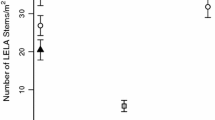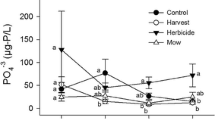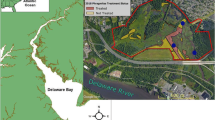Abstract
Herbicide applications have shown potential for control and management of invasive perennial pepperweed (Lepidium latifolium) in rangelands and tidal wetlands. However, reported efficacy of management methods varies widely, and the effects of more recently registered aquatic herbicides on non-target vegetation in riparian corridors and seasonal wetlands are poorly understood. In a replicated field experiment, we applied two registered aquatic herbicides to control L. latifolium upstream of a sensitive tidal wetland reserve as a preliminary step towards hydrologic restoration of a degraded ephemeral creek channel and associated seasonal wetlands. Herbicide treatments (imazapyr, 2,4-d) were applied at flower bud stage in May 2007 and monitored at 1 and 2 years following application. Two years of 2,4-d application were not effective in controlling L. latifolium (<1% control) but had minimal non-target impacts on the native plant community. Imazapyr reduced L. latifolium cover by more than 90% after 1 year of treatment as compared to untreated controls although non-target impacts on the native plant community were severe and persistent over the 2 years of observation. These results provide important information about the response of L. latifolium to management trials in a seasonal wetland and will be used to develop an integrated and adaptive management strategy for weed control as a component of a proposed tidal marsh restoration plan.



Similar content being viewed by others
References
Andrew ME, Ustin SL (2009) Habitat suitability model of an invasive plant with advanced remote sensing data. Divers Distrib 15:627–640
Bailey TL (1930) The geology of the Potrero Hills and Vacaville region, Solano County, California. Univ Calif Publ Bull Dept Geol Sci 19–15:321–333 (2 plts)
Berger JJ (1993) Ecological restoration and nonindigenous plant species: a review. Restor Ecol 1:74–82
Blank RR, Young JA (2002) Influence of the exotic invasive crucifer, Lepidium latifolium, on soil properties and elemental cycling. Soil Sci 167:821–829
Blank RR, Qualls RG, Young JA (2002) Lepidium latifolium: plant nutrient competition-soil interactions. Biol Fertil Soils 35:458–464
Boyer KE, Burdick AP (2010) Control of Lepidium latifolium (perennial pepperweed) and recovery of native plants in tidal marshes of the San Francisco Estuary. Wetl Ecol Manage 18:5 Online First™, 28 June 2010
Cox TK (1997) Perennial pepperweed in Idaho. Management of perennial pepperweed (tall whitetop). Special Report 972. US Department of Agriculture, Agricultural Research Service, Oregon State University, Agricultural Experiment Station, Corvallis, pp 23–25
D’Antonio C, Meyerson LA (2002) Exotic plant species as problems and solutions in ecological restoration: a synthesis. Restor Ecol 10:703–713
Downey PO, Williams MC, Whiffen LK, Auld BA, Hamilton MA, Burley AL, Turner PJ (2010) Managing alien plants for biodiversity outcomes—the need for triage. Invasive Plant Sci Manag 3:1–11
Fiedler PL, Keever M, Grewell BJ, Partridge DJ (2007) Rare plants in the Golden Gate Estuary (California): the relationship between scale and understanding. Aust J Bot 55:206–220
Greenfield BK, Blankinship M, McNabb TJ (2006) Control costs, operation, and permitting issues for non-chemical plant control: case studies in the San Francisco Bay-Delta region, California. J Aquat Plant Manag 44:40–49
Grewell BJ, DaPratro M, Hyde PR, Rejmankova E (2003) Reintroduction of endangered soft bird’s beak (Cordylanthus mollis ssp. mollis) to restored habitat in Suisun Marsh. University of California, Davis, Project 99-NO5 Report, CAL-FED Bay-Delta Eco- system Restoration Program, Sacramento, CA
Grewell BJ, Callaway JC, Ferren W (2007) Estuarine wetlands. In: Barbour MG, Keeler-Wolfe T, Schoenherr AA (eds) Terrestrial vegetation of California. University of California Press, Berkeley, pp 124–154
Grijalva E, Kerr D (2011) San Francisco Estuary Invasive Spartina Project 2008–09. Treatment Report
Howald A (2000) Lepidium latifolium. In: Bossard CC, Randall JM, Hoshovsky MC (eds) Invasive plants of California wildlands. University of California Press, Berkeley
Hutchinson JT, MacDonald GE, Langeland KA (2007) The potential for herbicide resistance in non-native plants in Florida’s natural areas. Nat Area J 27:258–263
Laubhan MK, Shaffer RL (2006) Seed germination of Cirsium arvense and Lepidium latifolium: implications for management of montane wetlands. Wetlands 26:69–78
Leininger SP, Foin TC (2009) Lepidium latifolium reproductive potential and seed dispersal along salinity and moisture gradients. Biol Invasions 11:2351–2365
Link SO (2009) Restoration perspectives for natural areas. Nat Area J 29:2–3
Mack RN, Simberloff D, Lonsdale WM, Evans H, Clout M, Bazzaz FA (2000) Biotic invasions: causes, epidemiology, global consequences, and control. Ecol Appl 10:689–710
Mooney HG, Hamburg SP, Drake JA (1986) The invasion of plants and animals into California. In: Mooney HA, Drake JA (eds) Ecology of biological invasions of North America and Hawaii. Springer, NY, pp 250–274
Renz MJ (2000) Element Stewardship abstract for Lepidium latifolium L., perennial pepperweed, tall whitetop. The Nature Conservancy, Wildland Invasive Species Team. Arlington, VA. http://tncweeds.ucdavis.edu/esadocs/lepilati.html
Renz MJ, DiTomaso JM (2004) Mechanism for the enhanced effect of mowing followed by glyphosate to resprouts of perennial pepperweed. Weed Sci 52:14–23
Renz MJ, DiTomaso JM (2006) Early season mowing improves the effectiveness of chlorsulfuron and glyphosate for control of perennial pepperweed (Lepidium latifolium). Weed Tech 20:32–36
Reynolds LK, Boyer KE (2010) Perennial pepperweed (Lepidium latifolium): properties of invaded tidal marshes. Invasive Plant Sci Manag 3:130–138
Robbins WW (1940) Alien plants growing without cultivation in California. Calif Agric Exp Stn Bull 637:128
Spautz H, Nur N (2004) Impacts of non-native perennial pepperweed (Lepidium latifolium) on abundance, distribution, and reproductive success of San Francisco Bay tidal marsh birds. Pt Reyes Bird Obs report to US FWS. Sausalito, CA
Spenst RO (2006) The biology and ecology of Lepidium latifolium L. in the San Francisco Estuary and their implications for eradication of this invasive weed. Ecology. University of California, Davis, p 95
US Fish and Wildlife Service (2005) Recovery plan for vernal pool ecosystems of California and southern Oregon. Portland, Oregon, pp xxvi + 606
Vanderhoff M, Holzman BA, Rogers C (2009) Predicting the distribution of perennial pepperweed (Lepidium latifolium), San Francisco Bay Area, California. Invasive Plant Sci Manag 2:260–269
Vitousek PM, D’Antonio CM, Loope LL, Rejmanek M, Westbrooks R (1997) Introduced species: a significant component of human-caused global change. NZ J of Ecol 21:1–16
Wetlands Research Associates Inc, Phillip Williams and Associates Ltd, The Planning Collaborative, Fulgham KO, Archaeological Resource Service (1990) Rush ranch enhancement and management plan. Report for the Solano Land Trust, Fairfield, California
Whitcraft CR, Levin LA, Talley D, Crooks JA (2008) Utilization of invasive tamarisk by salt marsh consumers. Oecologia 158:259–272
Wilcove DS, Rothstein D, Dubow J, Phillips A, Losos E (1998) Quantifying threats to imperiled species in the United States. BioScience 48:607–615
Williams CM, Holcombe DW, Hanks DR, Allen JR, Bruce LB, Perryman BL, Fernandez GCJ (2002) Effect of sheep grazing or mowing on the control of perennial pepperweed (Lepidium latifolium L.). Proc West Sec Am Soc Animal Sci 53:1–3
Wilson RG, Boelk D, Kyser GB, DiTomaso JM (2008) Integrated management of perennial pepperweed (Lepidium latifolium). Invasive Plant Sci Manag 1:17–25
WSSA (1994) Herbicide handbook. Weed Soc of America, Champaign, p 352
Young JA, Turner CE, James LF (1995) Perennial pepperweed. Rangel J 17:121–123
Young JA, Palmquist DE, Blank RS, Turner EC (1996) Ecology and control of perennial pepperweed (Lepidium latifolium L.). Proc CA Exotic Plant Pest Council 96:29–31
Young JA, Palmquist DE, Blank RR (1998) The ecology and control of perennial pepperweed. Weed Tech 12:402–405
Zaveleta E, Hobbs RJ, Mooney HA (2001) Viewing invasive species removal in a whole-ecosystem context. Trends Ecol Evol 16:454–459
Zedler JB, Kercher S (2004) Causes and consequences of invasive plants in wetlands: opportunities, opportunists, and outcomes. Crit Rev Plant Sci 23:431–452
Acknowledgments
We thank field assistants and laboratory helpers, especially J. Schneider, D. Talley, J. Burns, J. Pompa, B. Wallace, K. Poerner, J. Olson, and S. Kaff. Special thanks go to C. J. Futrell (USDA) for soil sample analyses. Thanks also to anonymous reviewers for helpful comments. This publication was prepared in cooperation with the California Bay-Delta Authority for research funded under California Bay-Delta Authority Agreement No. U-04-SC-005 to CRW. The views expressed herein do not necessarily reflect the views of any of those organizations. Access to the study site was granted by the Solano Land Trust and SF Bay NERR.
Funding sources
This publication was prepared in cooperation with the California Bay-Delta Authority for research funded under California Bay-Delta Authority Agreement No. U-04-SC-005 to CRW. The study sponsor had no involvement in the data collection, analysis and interpretation nor in the writing of the article. In addition, the study sponsor did not control or influence our decision to submit the manuscript for publication.
Author information
Authors and Affiliations
Corresponding author
Rights and permissions
About this article
Cite this article
Whitcraft, C.R., Grewell, B.J. Evaluation of perennial pepperweed (Lepidium latifolium) management in a seasonal wetland in the San Francisco Estuary prior to restoration of tidal hydrology. Wetlands Ecol Manage 20, 35–45 (2012). https://doi.org/10.1007/s11273-011-9239-x
Received:
Accepted:
Published:
Issue Date:
DOI: https://doi.org/10.1007/s11273-011-9239-x




